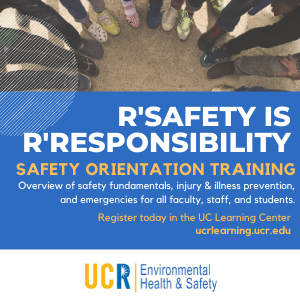Training Resources
Additional Training Resources for supporting safety in your program and department!
Handouts
Eye Protection
Heat Illness
Wildfire Smoke Protection Training
Posters
Access to Medical & Exposure Records
Workplace Discrimination & Harassment (Spanish version)
Eye Protection Options
GHS Labels
Injuries & Medical Treatment
Safety and Health Protection on the Job
Waste Disposal Requirements
Infographics
COVID-19 Summer Tips: Keeping Cool with a Face Covering
Health Effects of Heat Illness
How Does Heat Stress Affect You?
Other
UC Riverside EH&S has created a series of safety aides called Spotlight on Safety. Please feel free to use these in your team meetings, as a weekly safety topic, when reviewing site specific safety items or anytime you want!
Don't see the topic you're looking for? Let us know! Were always looking for ways to support our Campus Community!
May 2020 | Heat Illness Prevention
April 2020 | Zero Butts & Litter
March 2020 | Fall Prevention
February 2020 | Injury Prevention
January 2020 | Environmental Programs
November 2019 | Driver Safety
October 2019 | Fire Prevention
September 2019 | Workplace Injury Prevention
Provided by the National Safety Council.
August 2019 | Fall Protection Awareness
July 2019 | Heat Stress Prevention
Learn more about how to recognize symptoms and prevent heat stress. See all the Safety Programs at UCR.
Post the flyer below in your work environment!
Library of quality videos that you can view online
Standards
Objectives
Every instructor has objectives he/she wishes to accomplish during training. Learning objectives should be participant-focused and state desired learning outcome. Objectives should be identified for each training module that are measurable and observable. When constructing objectives, the main question that objectives answer is:
What should the participant be able to do differently after the training is completed?
Objecited should follow recognized models that aid in the construction of practical objectives, such as Bloom's Taxonomy or Roger Mager's Theory of Behavioral Objectives.
Bloom's Taxonomy
Objectives focusing on cognition (knowledge), affection (emotions), and psychomotor (skills) should be classified in to six types of learning. "Knowledge" is the lowest and "Evaluation" is the highest form of learning.
| Level of Learning | Examples |
| Knowledge | Participants will be able to recite the safety rules when cooking open flames. |
| Comprehension | Participants will be able to explain the steps for using fire extinguisher |
| Application | Participants will be able to apply the fire triangle concept to predict whether something will burn. |
| Analysis | Participants will be able to compare the different classes of fires |
| Synthesis | Participants will be able to design a room layout with an emphasis on safe exiting in the event of a fire |
| Evaluation | Participants will be able to produce a campus police involving use of candles in an office. |
Roger Mager's Theory of Behavioral Objectives
Objectives should include three characteristics: performance, conditions, and criterion (standard), such as in this example:
Note that training objectives emphasize what the participant will be able to do, not what the instructor indents to do. In each example, participants are expected to be able to accomplish specific goals by the end of the course. When developing learning objectives, be mindful of what is in your control in the classroom and what is out of your and the participant's control in the workplace.
There should be an emphasis on analysis and selection of a teaching method appropriate to the training target audience and the objectives. Instructors should adapt teaching methods that reach participants at all skill or literacy levels, learning styles and experiential levels. A diverse set of instructional strategies should be adapted to address a full range of cognitive levels.
Literacy Levels
Techniques to reach all literacy levels include:
- Assume that all participants are unequally skilled, or are not confident, in speaking / reading / writing / math.
- Make sure your handouts are visually appealing and easy to understand.
- Adjust your rate of speech and supplement with displayed print
- Do not rely on printed material alone. When information is important, make sure plenty of time for discussion is built into the class.
- Let the group know that they will not necessarily be expected to read material by themselves during the training. If other materials must be read aloud, read them yourself or ask for a volunteer. Never call on someone who does not volunteer.
- Make it clear that you will not put people on the spot. Let them know that you are available during breaks to talk about this or other concerns.
- Read all instructions aloud. Do not rely on written instructions or checklists as the only way of explaining an activity or concept.
- Plan for plenty of small group activities where participants get to work together on shared tasks. This includes facilitating reading, discussing, integrating new information, relating to life experience, recording ideas on flip charts, and reporting back to the whole group. In small groups, participants can contribute to the tasks according to their different backgrounds and abilities.
- Try to use as many teaching techniques as possible that require little or no reading.
- At the beginning of a class mention that you are aware people in the group may have different levels of reading and writing skills.
- Establish a positive learning situation where it is okay not to know and where questions are expected and valued. Participants need to be able to say when they do not understand and to feel comfortable asking for explanations of unfamiliar terms or concepts.
- Give out only the most important written material. Make any other materials available as an option.
- If possible, provide audio recordings of key readings so that participants have the option to listen and read along.
- Explain any special terms, jargon, or abbreviations that come up during the training. Write them on a flip chart.
- If participants have to write, post a list of key words. This can serve as a resource for people with writing or spelling difficulties.
Learning Styles
Techniques that appeal to different learning styles
Facilitate the tendency of people to use one of their senses more than others when learning. Visual learners (who constitute half the population) learn best by seeing information. Auditory learners (who are less common) learn best by hearing; they remember the details of conversations and lectures and may have strong language skills. Tactile learners (or kinesthetic) learn best by doing; and prefer hands-on experience.
|
Visual |
Auditory |
Tactile |
| Provide visual aids (i.e., pictures, charts, graphs, maps, flowcharts, diagrams, timelines, graphic organizers, outlines) Use multimedia (i.e., computers, videos, powerpoint, Prezi, mindmaps) Use color to highlight important points in text Ask them to preview chapters by looking at subheadings and illustrations before reading the text Illustrate your ideas as a picture or brainstorming bubble before writing them down Seat them up front, away from windows and doors (to avoid distractions) Write a story and illustrate it |
Encourage class discussions, debates, speeches, or teach-backs Provide an opportunity for them to recite the main points of a handout or lecture Allow them to read information out loud Create mnemonics, or musical jingles to aid memorization Use analogies and storytelling to demonstrate your point Encourage spoken answers to questions (i.e., interviews) instead of written answers (i.e., on a test) |
Provide frequent breaks during lecture Incorporate activities that allow for movement while learning (i.e., ergonomic exercises, hands-on use of a fire extinguisher, dancing) Ask them to take notes and encourage them to underline key points as they read Use skits and role-plays to emphasize information |
Adapted from Sadker & Zittleman (2006)
The Cone of Learning
Techniques that encourage active learning.
Instructors should implement participatory training methods that draw on participants’ own experiences, as well as encourage valuable exchanges between instructors and participant Facilitate teamwork and opportunities for participants to analyze health and safety problems in a group and develop solutions. Implement active learning techniques that allow you to observe who may be having difficulty with the concepts; and engage with them to ensure they understand. The best participatory methods 1) draw on participants’ own knowledge and experience about health and safety issues; 2) emphasize learning through doing without relying on reading; and 3) create a comfortable learning experience for everyone. The following are examples of methods to encourage participants to be actively engaged in class:
| Active Learning Technique | Practice |
| Think-Pair-Share | Give participants a task such as a question or problem to solve, an original example to develop, etc. Have them work on this 2-5 minutes alone (think). Then have them discuss their ideas for 3-5 minutes with a partner sitting next to them (pair). Finally, ask or choose pairs to share their ideas with the group (share). |
| Case Study | Provide a scenario for them to read. Have them discuss and analyze the case, applying concepts, data, and theory from the class. They can work as individuals or in groups or do this as a think-pair-share. Consider combining this with a brief in-class writing assignment. |
| Concept mapping | Enable them to create visual representations of models, ideas, and the relationships between concepts. Have them draw circles around concepts and connect phrases with lines. |
| Debates | These can be formal or informal, individual or group. Allow participants the opportunity to take a position and provide information to support that view. Consider asking participants their personal view on an issue and then make them argue the opposite position. |
| Games | Games such as jeopardy and crossword puzzles can be adapted to course material and used for review, for assignments, or for exams. |
| Review session | Ask each participant to identify at least one question related to the material s/he doesn't understand, and to try to answer a question raised by another participant. Encourage them to ask questions; and allow others to volunteer answers. Provide participants who ask/answer questions receive a "treat" (i.e., small candy bars, gum, and boxes of raisins. |





